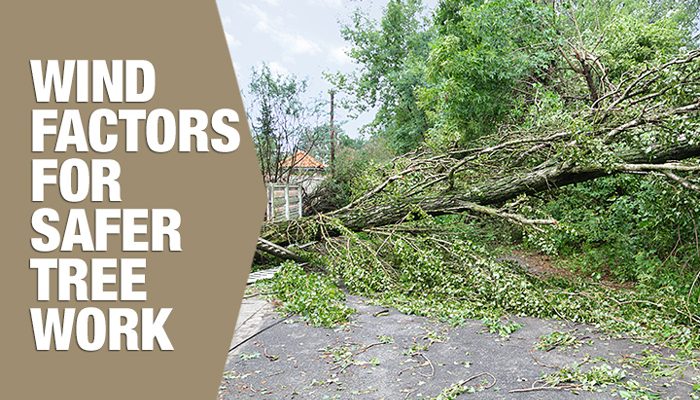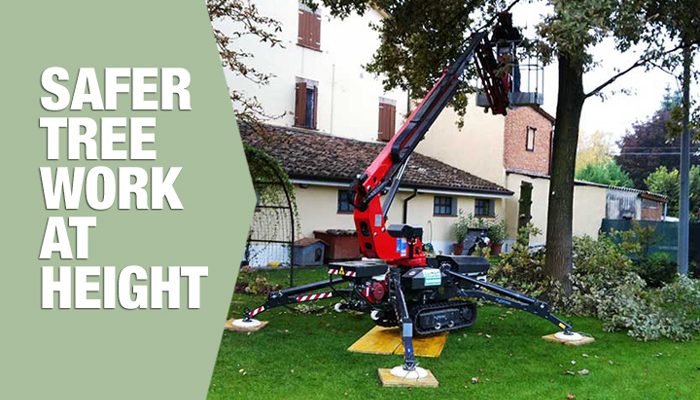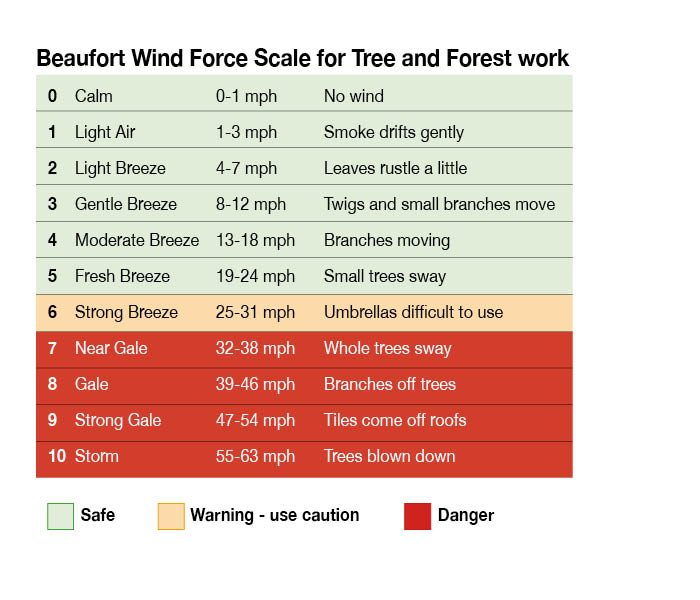
Safer Tree Work and Wind Factors
27 January 2018
Tree work with powered access platforms and the effect of the wind
Just as the sailor keeps a “weather eye” on the wind, so must the MEWP operator and workforce. As part of the pre-work risk assessment it is important not to forget the possible effects of a change in wind speed. This is particularly so for those offering tree work.
A powered Spiderlift access platform that works outside will operate up to a maximum wind speed that will have a mark on the machine or available in the hand manual. Operation above the maximum wind speed could cause instability and affect the safety of both operator and those below. As a guide, wind speeds above 28mph pose a safety risk making it uncomfortable and dangerous for the operator to continue to work.
Other Wind Factors During Tree Work
Other wind factors may also increase the risk of accidents during tree work. Wind chill has a serious impact on the ability to work safely at height. On a cool calm day with a temperature of 10 degrees C, it may feel comfortable enough. However, when the wind rises to 20mph the effect on the hands and face is to lower it to 0 degrees! If work was to begin at 0 degrees C on the ground and the wind become to rise to 20mph, then the effect on the skin comes -15 degrees C. Obviously it is important to wear very warm clothing at such temperatures.
It should always be remembered that wind speed increases with height. At 20 metres above ground it could increase by 50%. The recommendation is that operators carry with them a hand held anemometer that they can quickly check at platform level. This essential piece of arborist equipment is available for less than £10 and measures wind speed, wind gust, wind chill and temperature. The anemometer comes with a lanyard for all powered access platform operators.
The Beaufort Wind Force Scale
This wind force scale was devised at the beginning of the 19th century. It is still useful today as it is based on visual and subjective observation. The normal scale ranges from zero to 10. Working at height on at the scale of zero to 5 is considered safe. However at Level 6 – Strong Breeze – opertaters will be more cautious. Wind speed at this level ranges from 25 to 31 mph. The “safe” speed of 28 mph can easily move into a dangerous situation. All tree work at levels above Level 6 is completely unsafe.
Summary
Always include wind speed in the pre-start risk assessment and monitor throughout the progress of the tree service when using forestry access platforms. The hand held anemometer is a cheap practical tool for tree work when operating in the raised basket. A quick check will reduce the risk of instability and highlight freezing “wind chill” conditions.

Tree Cutting Equipment
21 January 2018
Powered access platforms – the safe choice for tree cutting equipment
The value of trees to our environment is high on the agenda in managing our atmosphere. Often referred to as “the lungs of the planet” they absorb carbon dioxide and release oxygen; they stabilise soil by absorbing water; and provide a home for our wildlife.
Careful management of this vital resource relies on expert tree surgeons and their tree cutting equipment. Some work can be done at ground level but much is done at height. As with all working at height, risks are involved and need to be carefully managed.
The traditional climbing gear for arborists consists of ropes and ladders, these however carry considerable risks for the user. A much safer way to reduce the likelihood of an accident is by using a powered access platform. A “spider” platform is the perfect addition to any arborists tree cutting equipment.
The HSE and The Arboricultural Association have both published guides and a code of practice for a safer working environment when working at height with trees. The key element is a risk framework that is properly planned, appropriately supervised and carried out in a safe manner.
Roles and responsibilities should be clearly identified in risk management and planning. Tree key personnel need to be identified –
• Responsible Person – who determines a generic assessment and risk control procedures which are largely unchanging from site to site
• Competent person – who appraises specific on-site risks including emergency procedures and protocol
• Proficient operator – conduct the on-site appraisal on the day of working, validating and applying the safe systems of work identified by the competent person.
Both the HSE and the Arboricultural Association highlight that before any tree work operations begin, a risk assessment must be made. They identify that using tree service equipment platforms, such as a Spider platform, lowers the risk of accident when compared with rope and ladder.
The risk assessment will include a pre-work evaluation as to whether tree work at height is appropriate; a check that safe systems are in place; that operators are properly trained; identification of site-specific hazards; an emergency plan is in operation; and that everyone concerned has a clear idea of the tasks to be completed.
There are two important concerns specifically for powered access platform operators:
• Individuals should identify the drop zone
• They should use appropriate and accurate cutting techniques
Power access platforms are quicker and safer for arborists and are the perfect tree service equipment operating with versatility and flexibility in challenging locations. As with all work at height, a pre-work Risk Assessment is essential for the safety of all.
Promax Access specialise in providing high access tree cutting equipment for the Forestry industry and can offer a wealth of advice on choosing the right access platform for the job. Contact us now.

MEWP Rescue Planning
14 January 2018
IT’S DOUBTFUL that the poet Robert Burns had a powered access platform in mind when he wrote “To a Mouse”. However, it is to the great Scottish Bard himself that we owe the phrase: “The best-laid plans of mice and men often go awry”. He wrote the poem after rescuing a mouse nest he had accidentally ploughed up. The observation is timeless and applies to all: No matter how a project is planned, accidents can happen.
It’s also doubtful when MEWP rescue planning that the plight of a mouse will spring to mind. But perhaps what should, is a rescue plan in case the unexpected should happen. Not for a mouse of course, but for MEWP operators and workforce.
As mentioned before, carrying out a detailed and thorough risk assessment of the job location will identify most of the potential hazards before the job starts, but sometimes human error or acts of nature, such as fast changing or extreme weather conditions, can mean that things still go wrong. It is important to have a rescue plan in place to support and assist the workforce in case of an accident or mechanical failure.
MEWP Rescue Planning
Most forestry access equipment has back-up systems built into the machine which enable the operator to return the raised platform back to ground level. Though these systems rarely fail it can still happen so it is vital to have a plan for how people can be brought down safely.
Any MEWP rescue planning should comply with current health and safety legislation such as the 2005 Work at Height Regulations. It is important to do a risk assessment for the rescue and keep a record of this assessment and all details of the rescue as this may be important to refer to at a later date.
In the event of a rescue being required:
• Activate all normal emergency lowering procedures if possible
• Contact the manager of the site or project to report any failure of back-up emergency systems
• Get the powered access platform checked by a qualified engineer to see if an on-site repair can be carried out
Basket-to-basket rescue
If it is not possible to repair the lowering mechanisms then a basket-to- basket rescue may be necessary. This can be complicated and poses additional health and safety risks so it is important to follow the following steps:
• The rescue machine should be placed in the safest position to minimise any additional danger to anyone involved in the rescue
• Place the two machines adjacent to each other with the smallest possible gap between them
• Attach a double lanyard to both the person being rescued and the anchor points on both machines before the rescue takes place
• Never overload the rescue machine as this could lead to over-tipping or delay the rescue operation
In exceptional circumstances, where a basket-to-basket rescue is not feasible, emergency evacuation systems such as a crane rescue could be used.
Summary
Having a rescue plan is an essential part of planning a job and, though access equipment is safe and efficient, there are rare occasions when jobs don’t go to plan. Carry out a full risk assessment, keep a record of any rescue situation as it happens, and try the simplest solution first before attempting a more complicated rescue procedure and the situation can be resolved quickly and carefully.

MEWPs. Be extra careful in winter!
7 January 2018
Don’t get complacent in fast changing weather conditions.
The mid-winter weather in the UK is always volatile. Conditions can change from sunshine to sleet and snow showers in a few hours. Conditions may be fine when starting a powered access platform job on a chilly but pleasant morning, but by lunchtime, they can quickly become treacherous.
Winter MEWPS are not only designed to be safe and fully functional in bad winter weather but working in quickly changing conditions can increase the health and safety risks for workers and create additional access problems.
Whether you are onsite or offsite, working at height requires a suitable risk assessment to avoid potential dangers. However, fast changing weather may require constant monitoring of the initial risk assessment.
What was good at 8.00am may not be the same after lunch.
Carrying out a risk assessment does not need to be overly complicated but it does need to be an important part of planning and completing a job. Both the supervisors and the staff should be aware of the potential dangers so they can actively avoid them.
The HSE website provides full and detailed advice on planning and completing a risk assessment for a wide range of jobs but here are the five main points to consider:
• Identify the Hazards – Walk round the site and make observations. Some of these may be obvious but it is worth getting a second opinion in case there is something you haven’t noticed.
• Decide who might be harmed and how – It may be a job onsite or there may be safety concerns for the general public. Make sure staff are adequately trained to complete the work and briefed on the requirements of the job.
• Evaluate the risks and decide on precautions – Avoid working at height where it is reasonably practicable to do so, for example can you get equipment or materials prepped at ground level?
• Record your findings and implement them – Check the maintenance of the powered access platform and other equipment and make sure that workers know how to operate it safely and effectively. Take extra steps to prevent any person falling a distance that could cause personal injury and use equipment to minimise the distance and consequences of a fall if necessary, such as safety nets.
• Review your assessment and update if necessary, not just at the start of a job, but hourly if necessary. Circumstances change all the time so your assessment of the risks will too.
Summary
Powered access platforms make working at height safer and quicker but they do not remove all the potential risks that changeable bad weather can bring. Constant monitoring of the risks will ensure that potential problems are managed and be prevented. Each job is different but the aim is the same: complete it without an incident or injury.
